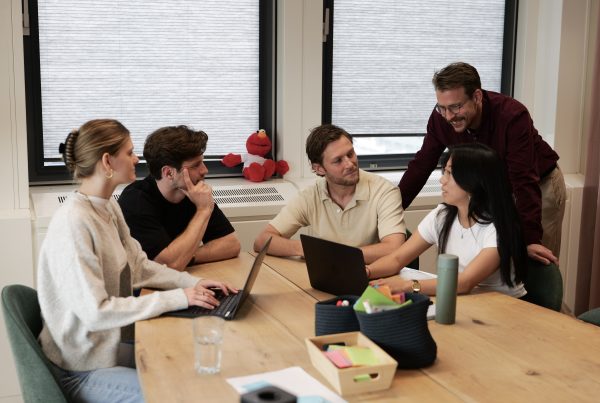In our efforts to become net-positive, we have partnered with klimate.co and developed an internal working group to establish our new climate impact policy. The driving force behind this is Fleur Fok, a Senior Consultant in our Sustainability practice. Together, we discuss becoming a climate advocate, setting up a climate policy, and carbon removal strategies.

How did you become our internal climate impact ambassador?
At ADC, we organise a Strategy & Culture Day twice a year. Apart from some team building activities, we use this day to look back on what we accomplished so far and discuss our goals for the coming period. In the summer of 2022, everyone had the opportunity to pitch their own ideas. What would you change if you were the CEO of ADC?
Driven by the recent increase in business trips to our new Copenhagen office, I decided to pitch for carbon offsetting our flights. The pitch resonated with everyone. In the weeks that followed, my colleagues kept coming up to me, one-by-one, to discuss our climate impact. Should we only offset flights or also look at our broader climate impact? Is offsetting enough? Does it even help? Quickly it turned into a personal passion project to discover our best course of action.
How did you begin to set up a new climate policy?
I decided to set up an internal climate impact committee. At ADC, we often set up working groups when we want to explore company changes as a collective. It is a great way to ensure that ideas are broadly supported by our colleagues.
Our committee had one goal: to propose a new climate impact policy to our management team before the end of the year. We had discussions on our company values, the cost of carbon, and offsetting strategies. We even talked about setting up a collective fund with other international companies to develop better international train connections (and better Wi-Fi in those trains). I worked on facilitating the sessions and summarising our collective thoughts afterwards. In the end, this led to our current climate impact policy.
What did the climate impact committee propose?
For now, we decided to focus on our operational emissions to ensure quick and effective results. In summary, we proposed a three-step approach to limit our emissions: avoidance, transparency, and compensation.
When addressing climate impact, the first step should always be avoidance. For example, avoiding waste, unnecessary emissions, and products that are more harmful than others. The second step is transparency. When we work, we pollute, so let us at least be transparent about it. On the road to improvement, it helps to know what our largest contributors are. Collecting the relevant data means that we can monitor these contributors and our total impact in a clear KPI (CO2eq) over time.
Lastly, we recognise that carbon removal – rather than offsetting – is an essential part of our global journey to net-zero. Therefore, we have committed to removing our operational carbon emissions in partnership with klimate.co, a company that provides and evaluates high-quality carbon removal projects.
Why did ADC decide to partner with klimate.co?
We want the future to be brighter because Amsterdam Data Collective exists, and we believe we work towards that through our work. In doing so, we also want to take accountability for our own climate footprint. We recognise that carbon removal plays an essential role in our global path to becoming net-positive.
Therefore, we decided to partner with Klimate.co to remove our operational carbon emissions. They provide responsible companies with access to high-quality, innovative, and verifiable carbon removal solutions aligned with science. Their core purpose is to scale and accelerate the development of carbon removal methods and technologies needed to reverse climate change.
So, what are we doing to avoid future carbon emissions?
This is by far the most difficult part. How do you determine what products and actions are necessary to do our work? Over the years, we have had initiatives to sign a green electricity contract, limit our food waste, and encourage our employees to take public transport over car rides.
Going forward, we did not want to propose strict rules for every type of decision that has to be made, because we believe in the ownership of our colleagues. Instead, we decided to capture our collective values in a new set of green guidelines. Writing down these guidelines is meant to further empower our (future) colleagues to consider alternatives and make the right decision every time. Additionally, by choosing high-quality carbon removal projects, we have put a more realistic price on carbon, disincentivising carbon heavy decisions even further.
And what do we do with the carbon emissions that we can’t avoid?
As a data company, we can develop all kinds of beautiful dashboards, but as consultants we decided to keep our initial solution simple and effective. Instead of getting every little detail perfect, our focus was on getting the largest contributors right.
First, we set up a framework and gathered the necessary data to estimate the total emissions in CO2eq in four domains: travel, food, electricity usage, and consumption of large products (e.g., laptops, screens). Whenever there were uncertainties, we were conservative in our estimates. We assumed, for example, that all kilometres travelled by car were travelled on gasoline instead of a mix of gasoline and electricity.
Second, when we had calculated our total estimated carbon emissions, we started looking for the right partner to remove our operational emissions. There are plenty of untrustworthy carbon credits on the voluntary carbon market [Guardian], and we wanted to ensure that we invested in the right carbon removal strategy. We have found this partner in Klimate.co.
What is a carbon removal strategy?
There is so much to consider when investing in carbon offsetting, so it helps to define a strategy. Although we need all kinds of investments to happen in the fight against climate change, it is good to ask ourselves: what do we want to achieve by investing in carbon offsetting?
Following the Oxford principles [Oxford], it is essential to move from future emission avoidance towards carbon removal and (long-term) storage. Carbon removal – rather than offsetting – is necessary to reverse climate change. Additionally, if we want to compensate for past emissions, it only makes sense to compensate for them with removal that has already taken place (ex-post) instead of removal that will happen gradually over the years to come (ex-ante).
Furthermore, investing in nature-based solutions like reforestation can have many co-benefits, such as biodiversity, social, and adaptation benefits. However, planting trees throughout the world (where the ground allows us) is insufficient to reach the minimum of 10Gt of CO2 removal per year that is needed to reach net-zero in a best case-scenario [Mind-the-Gap].
If you are interested in our exact strategy and further advice, read our follow-up article on carbon offsetting removal: insights from our path to become net-positive.
There is a lot to consider, are we sure we made the best choices?
We can never be one hundred percent sure. We must, however, do something, do it now, and continue validating the results. There are enough examples of companies that buy cheap carbon credits that then turn out to be harmful.
Therefore, our priority is to ensure that we are making a well-informed decision. This mentality has resulted in our decision to become net-positive. We first determined a removal strategy and then decided to remove 25% more than our operational emission estimate. In this way, we have a buffer for the underestimations in our current calculations, mitigate climate integrity risks, and set an example of a net-positive organisation.
What is next in our path to becoming net-positive?
What we have set up works, but we also came across so many steps that can be improved. For example, we want to improve the way we capture our operational data, so that we can automate some of the calculations. Naturally, we will now also include our new Danish and Sweden offices in our calculations and carbon removal strategy. Additionally, we want to think about how we can measure the impact we have at our clients and investigate if we can improve it over time.
Any last words?
I knew that making a positive impact was always part of our DNA. Only recently did I realise that what we were doing was part of a bigger shift: the type of transformation that is common for a growing company. We were professionalising our social responsibility by explicitly writing down our values and ensuring that positive impact is not left up to the goodwill of a few individuals.
Lastly, I am very proud to be part of a company who can support net-positive claims. I want to not only invite anyone to challenge us to improve the steps we have taken so far, but also encourage others to set up similar policies within their company. Let’s go net-positive!
Let's shape the future
Curious to learn more about our partnership with klimate.co? Interested in setting up your own climate impact policy to work towards becoming net-positive? Get in touch with Fleur Fok or visit our contact page.

What stage is your organisation in on its data-driven journey?
Discover your data maturity stage. Take our Data Maturity Assessment to find out and gain valuable insights into your organisation’s data practices.







